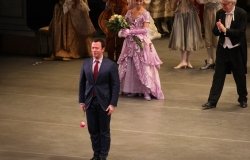Porgy & Bess at 80: Rethinking Russian Influence on American Culture
East European musical and theatrical masters arriving in the United States beginning in the 1890s immediately recognized and praised the contributions of African Americans to American culture.
East European musical and theatrical masters arriving in the United States beginning in the 1890s immediately recognized and praised the contributions of African Americans to American culture. Beginning with Czech composer Antonín Dvořák – who argued during the 1890s that “Negro melodies” would create a distinctive “American school” of operas, symphonies, art songs, and chamber works – and continuing through the early twentieth century, European immigrant musicians and theatrical performers such as – Dvořák, George Balanchine, Jerome Kern, and Kurt Weill -- sought out African American creative partners. They continued to do so in the face of ever sharper criticism by the self-proclaimed white arbiters of high taste, such as authoritative Boston music critic Philip Hale who called Dvořák naïve and a “Negrophile.” The attached article places the well-documented contributions of several Russian masters to the creation of the American Folk Opera Porgy & Bess within the context of this broader story of race in America. In doing so, it tells an early chapter in a broader story of twentieth century American culture which continues with the seminal role played by Atlantic Record founders Ahmet and Nesuhi Ertegun – the sons of a pre-World War II Turkish Ambassador in Washington – in bringing the sounds of African American creativity into the cultural mainstream. As much as the creation of Porgy & Bess is an American story, it is also a tale of early twentieth century New York and the effervescent blending of cultures taking place there which undermined entrenched notions of the superiority of European cultural forms within a white American elite.
The article appears in the Montreal on-line literary journal Cosmonauts Avenue. For the version published in the journal see the link below.
About the Author

Blair A. Ruble
Former Wilson Center Vice President for Programs (2014-2017); Director of the Comparative Urban Studies Program/Urban Sustainability Laboratory (1992-2017); Director of the Kennan Institute for Advanced Russian Studies (1989-2012) and Director of the Program on Global Sustainability and Resilience (2012-2014)

Urban Sustainability Laboratory
Since 1991, the Urban Sustainability Laboratory has advanced solutions to urban challenges—such as poverty, exclusion, insecurity, and environmental degradation—by promoting evidence-based research to support sustainable, equitable and peaceful cities. Read more










